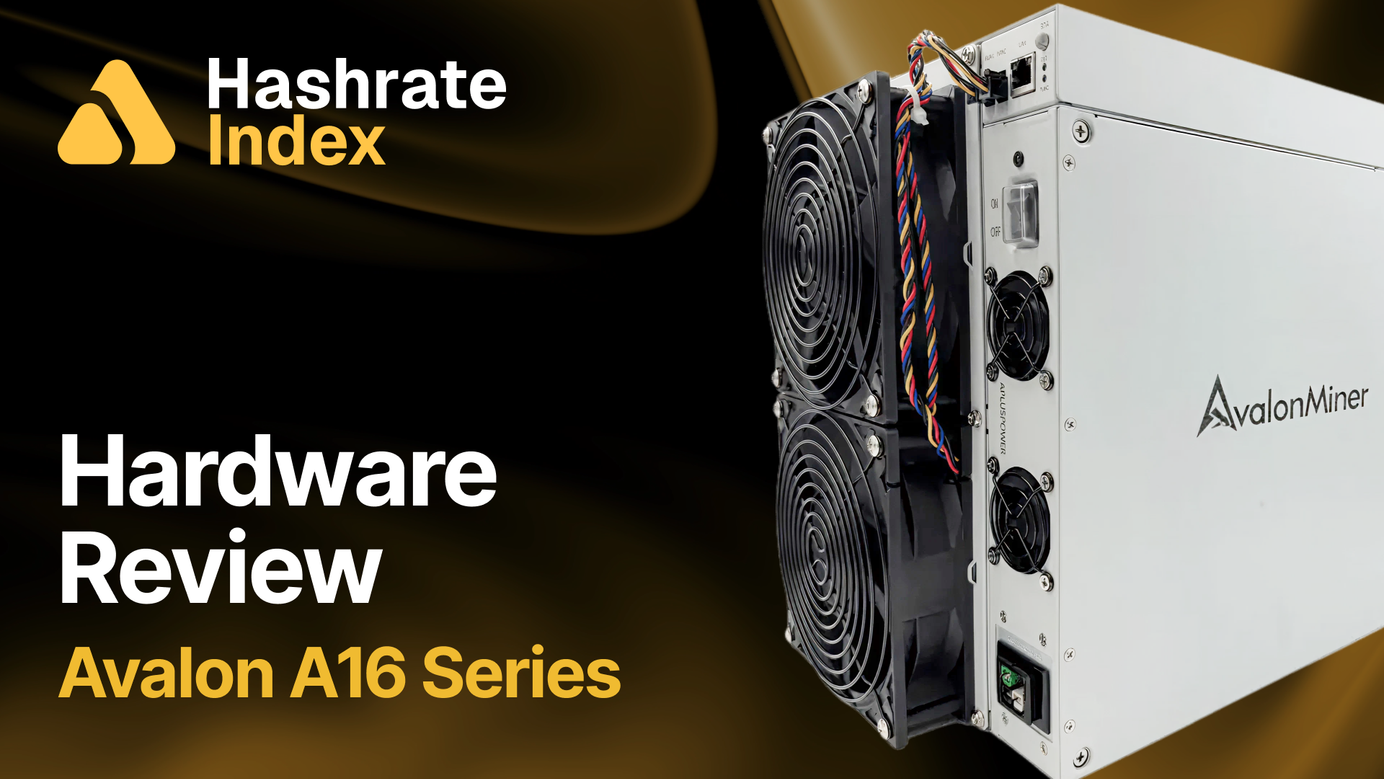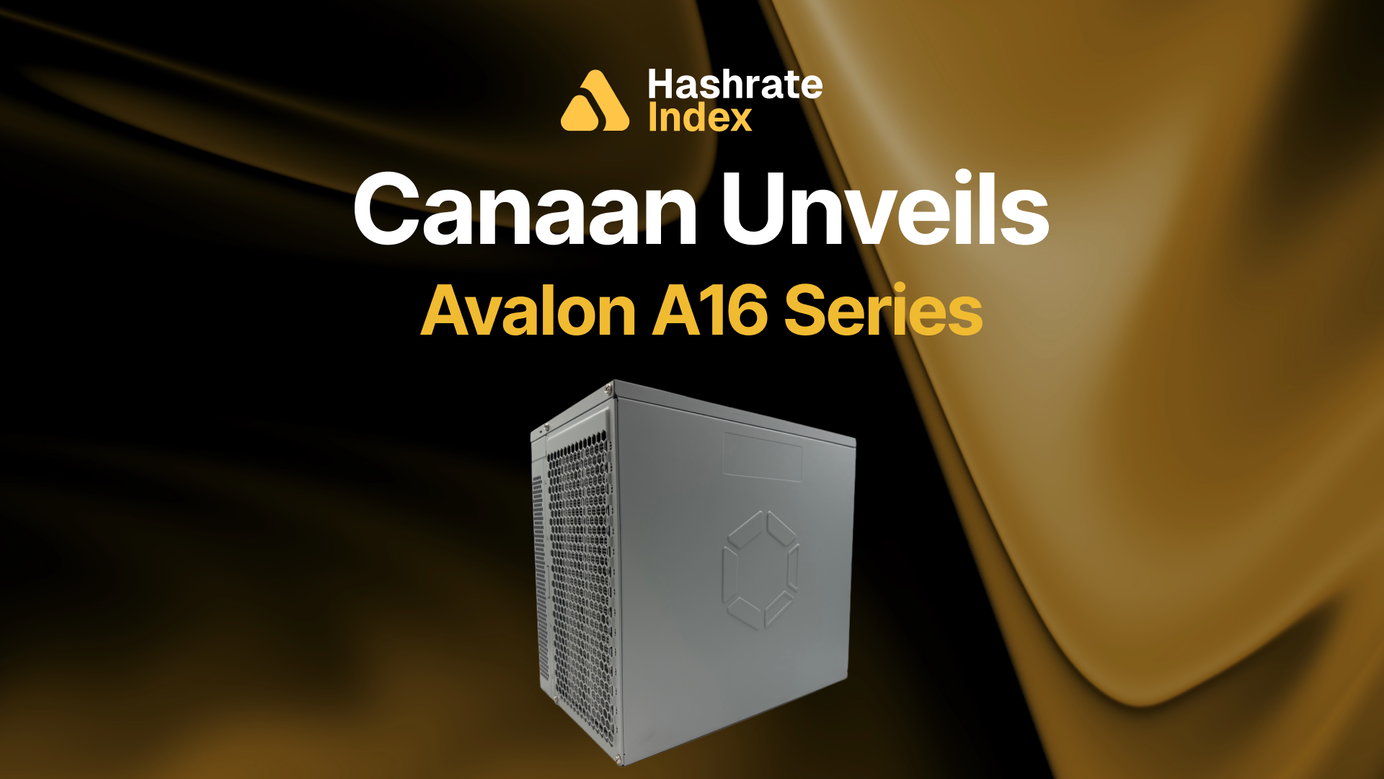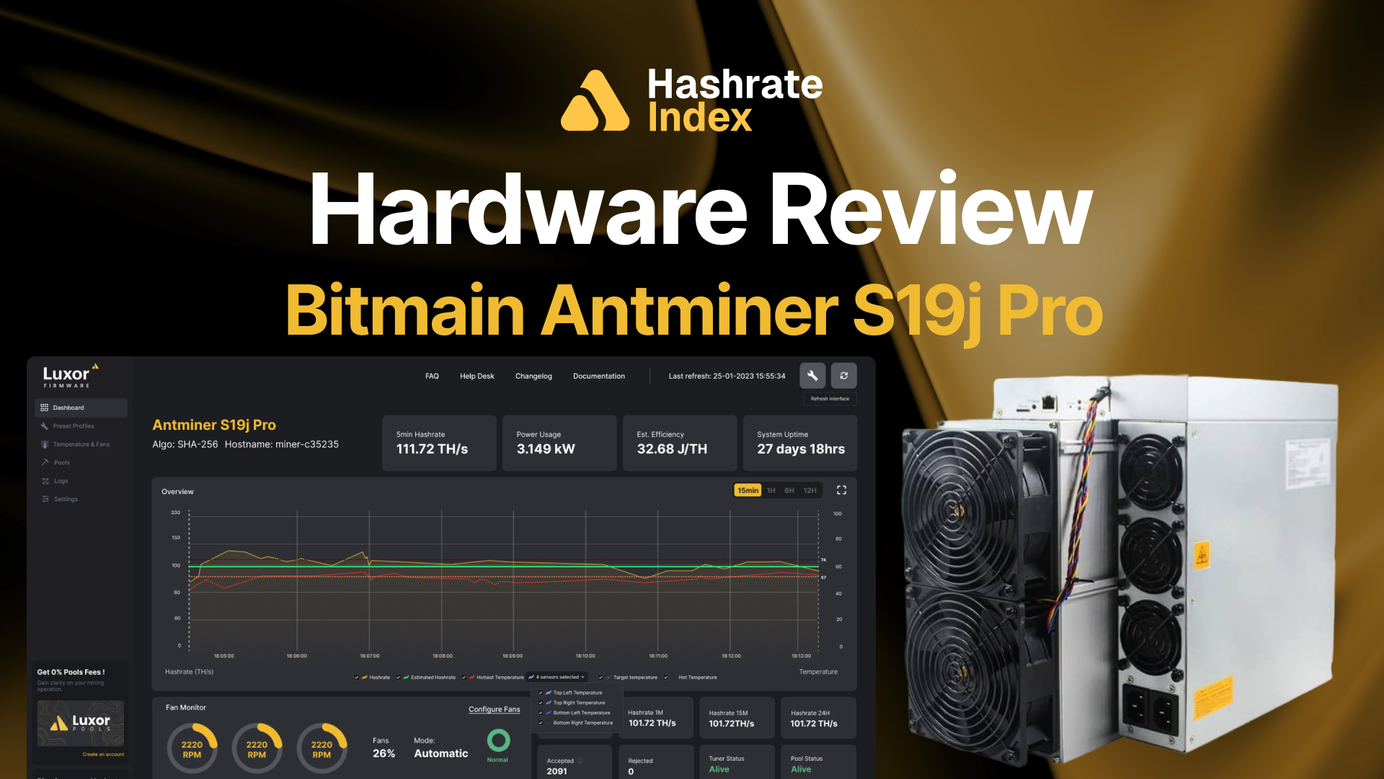
The Ultimate Hardware Review: Bitmain Antminer S19j Pro
A Full-stack Bitcoin mining analysis.
Hashrate Index’s Ultimate Hardware Review Series is a deep dive into Bitcoin mining hardware. In this post, we cover physical components, performance testing, and advanced optimization strategies (firmware, energy, and finance) for the Antminer S19j Pro by Bitmain.
Introduction
Bitcoin mining machines are specialized computers designed to exclusively perform cryptographic computations (SHA-256 hashing) for Bitcoin’s Proof-of-Work consensus mechanism. This process secures the blockchain, transforming raw computational power into decentralized cybersecurity.
Bitcoin is — by far — the most powerful computer network in the world, as demonstrated by its immense computational scale. Hashrate Index's Bitcoin Mining Consumption Index estimates the global Bitcoin network to have drawn ~25 GW of power (as of November 2025), with a total network hashrate of ~1,100 EH/s. This unprecedented scale of globally distributed computing is what makes Bitcoin special, and the S19j Pro is at the forefront of it all.
TLDR
S19j Pro At A Glance
- Machine Model: Antminer S19j Pro
- Manufacturer: Bitmain
- Release Date: May 2021
- Cooling Option(s): Air
- Target Market: Industrial
Stock Specifications
- Power Consumption (Stock): 2714W–3068W (varies by hashrate variant)
- Nameplate Efficiency (Stock): 29.5 J/TH
- Hashrate Variants (TH/s): 92 / 96 / 100 / 104
- Control Board(s): AMLogic, XILINX, BeagleBone
LuxOS Specifications (100 TH/s variant)
- Power Consumption (default AutoTune): 2690W (-14.5%)
- Optimized Efficiency (default AutoTune): 26.7 J/TH (+10.5%)
Overclocking Hashrate Potential (TH/s)
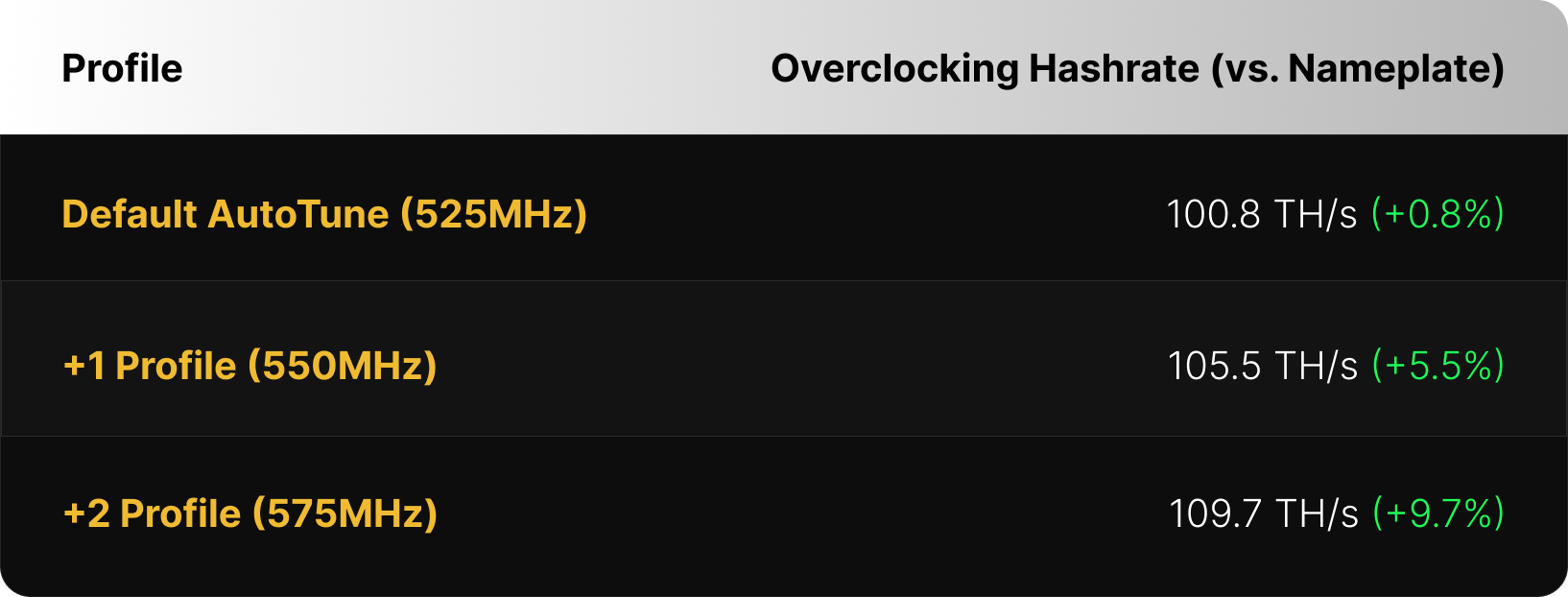
Underclocking Efficiency Potential (J/TH)
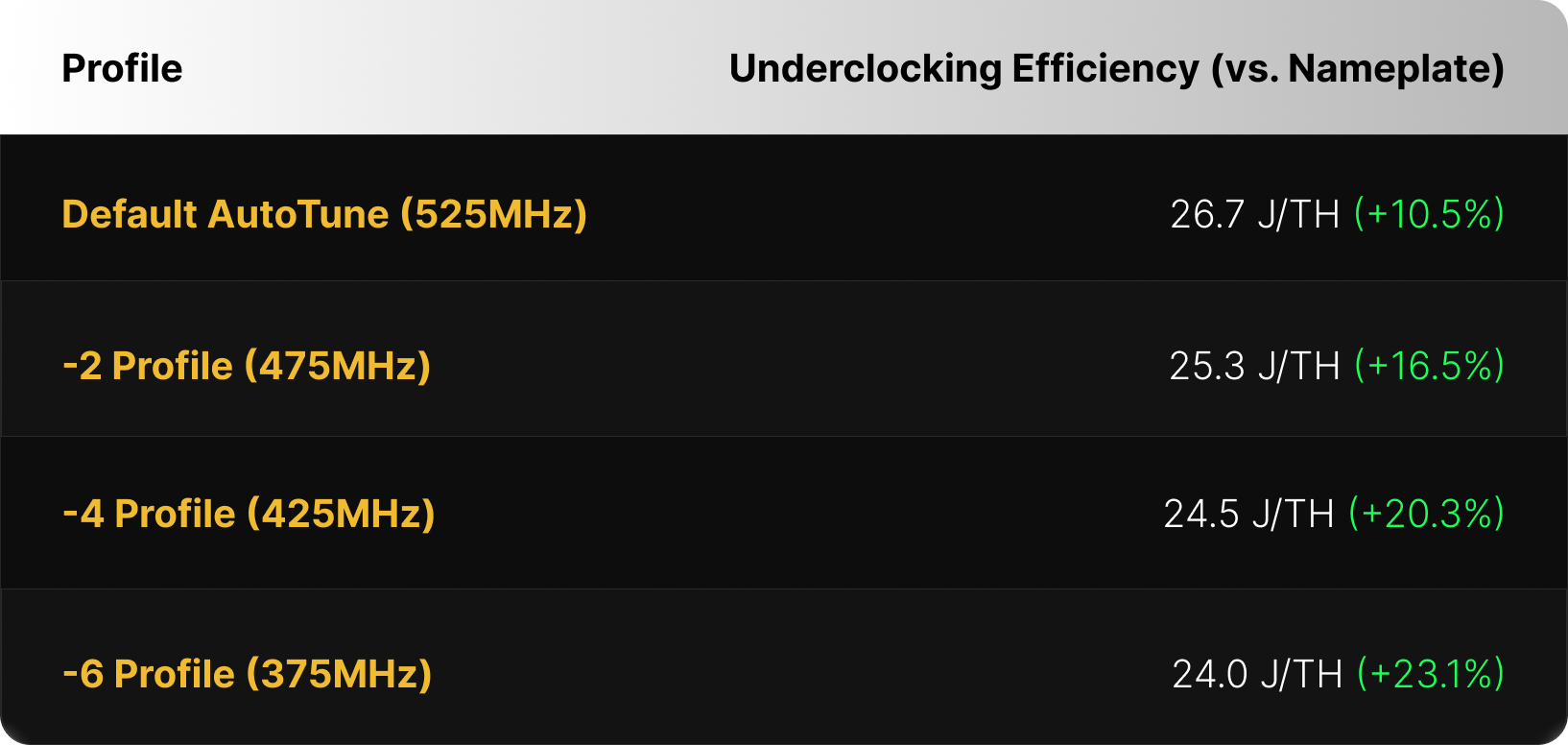
Mining Economics
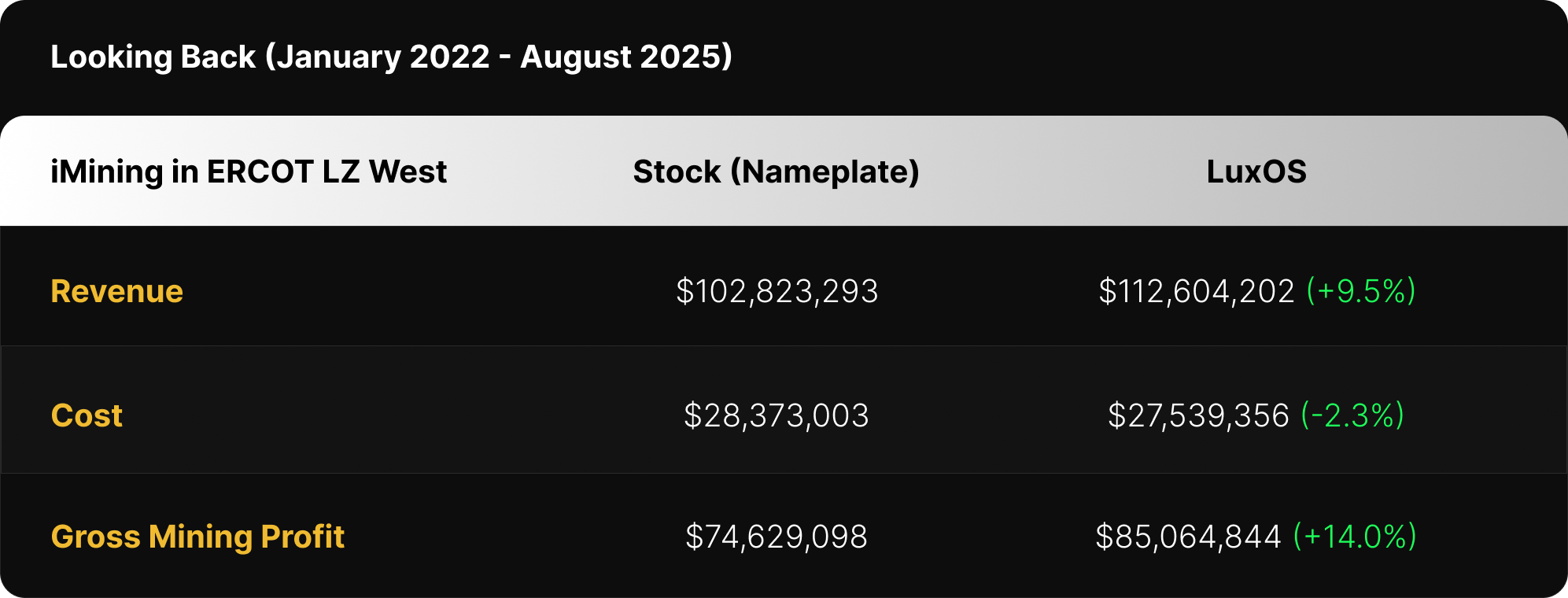

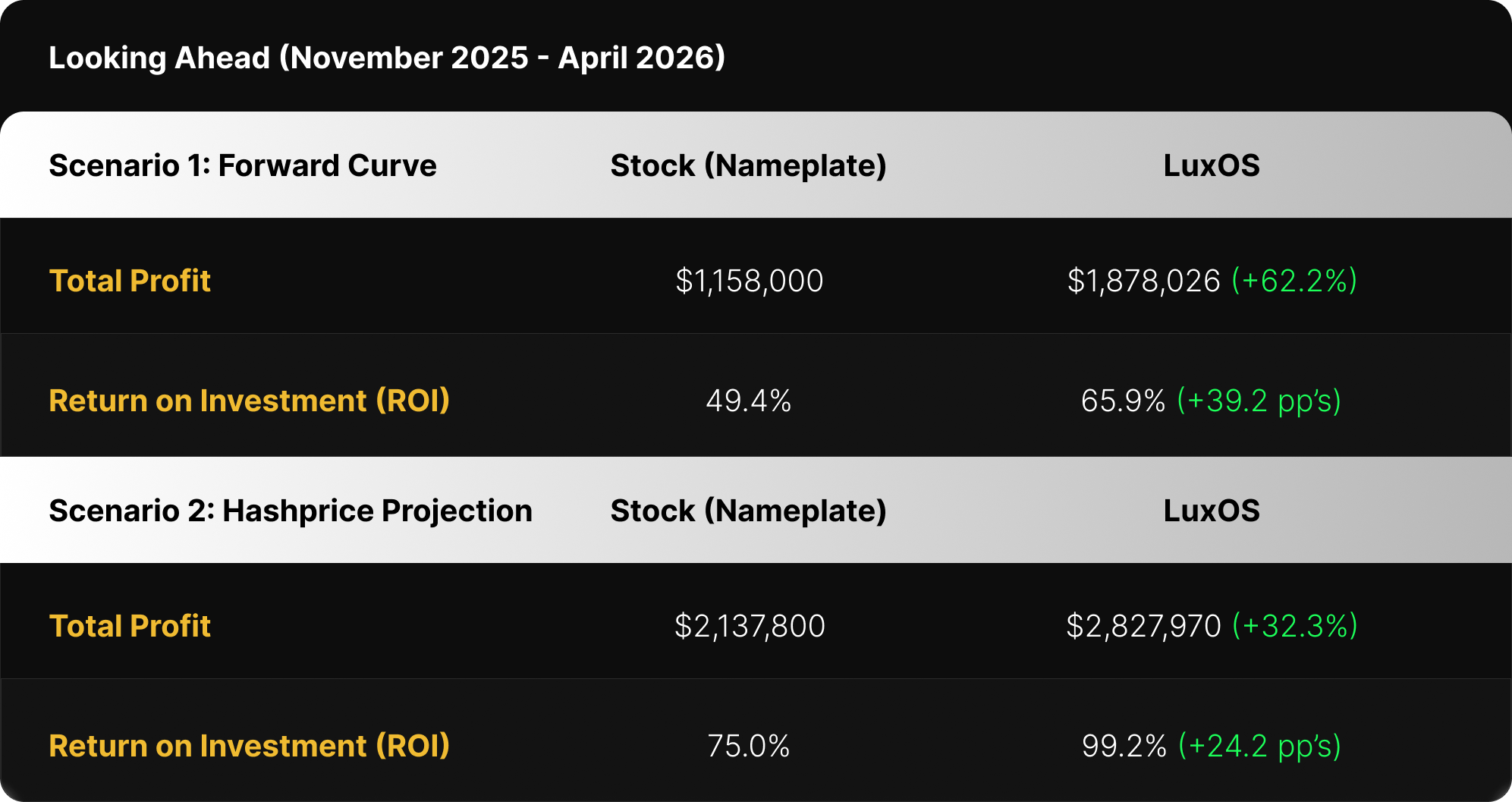
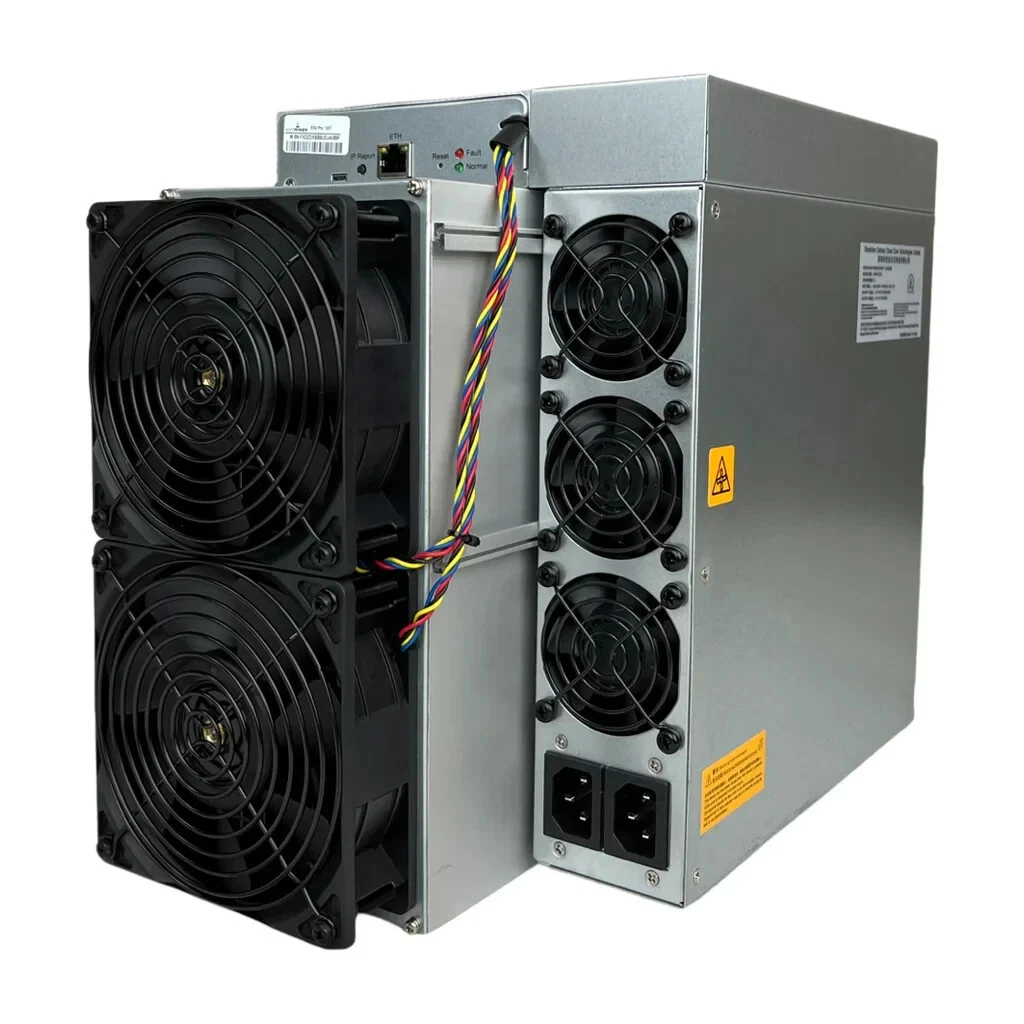
Hardware Components
Bitcoin mining machines consist of four core functional systems that work together to convert electrical power into SHA-256 hashes.
- Power Supply Unit (PSU): converts AC power into regulated DC power that ASIC chips require to work.
- Control Board: serves as the central processor “brain” that coordinates machine operations, firmware management, and network connectivity.
- Hashboards: contain the application-specific integrated circuit (ASIC) chips which perform the work (SHA-256) for earning mining rewards.
- Cooling System: manages thermal load to maintain optimal operating temperatures.
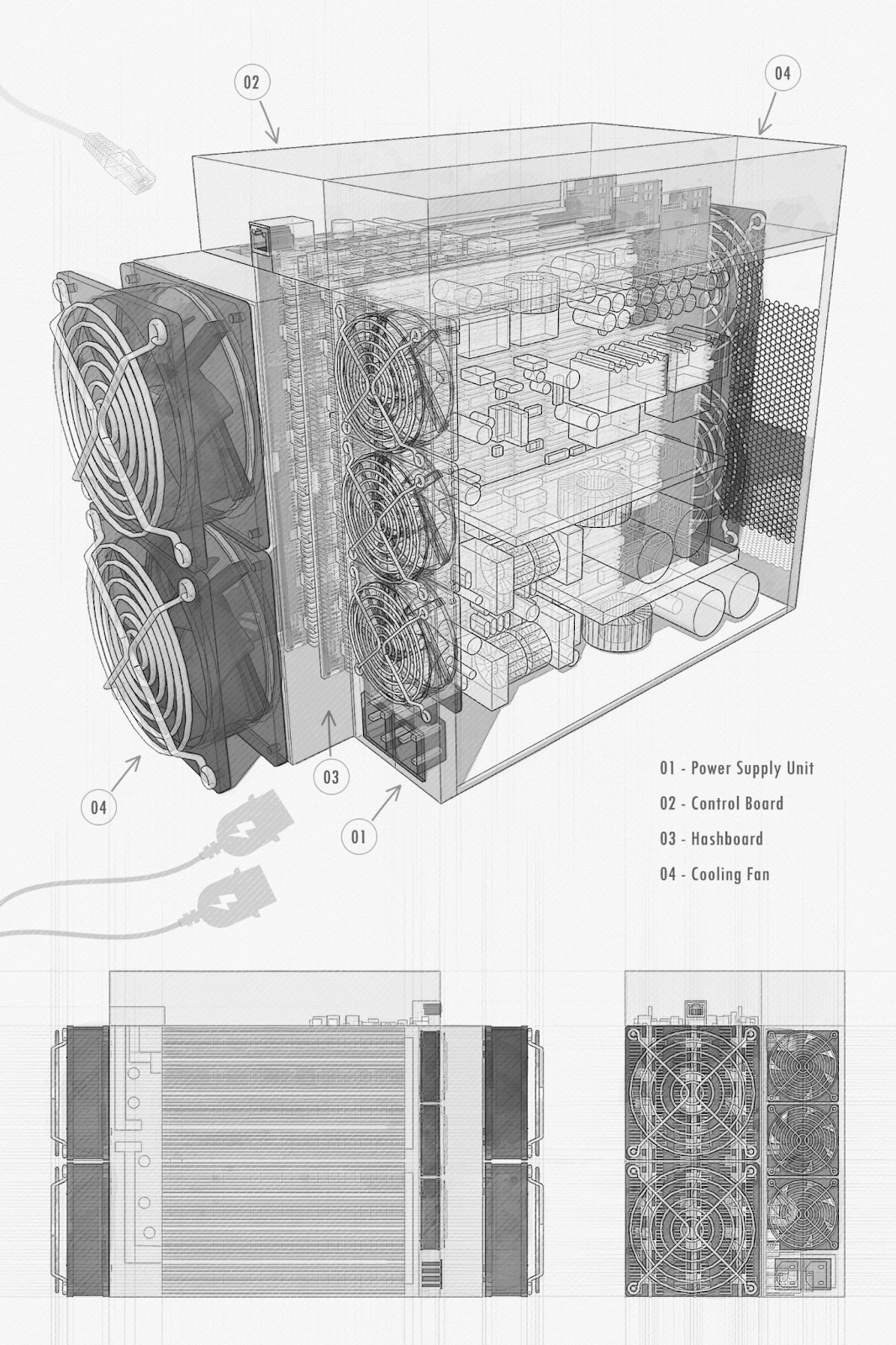
1. Power Supply Unit (PSU)
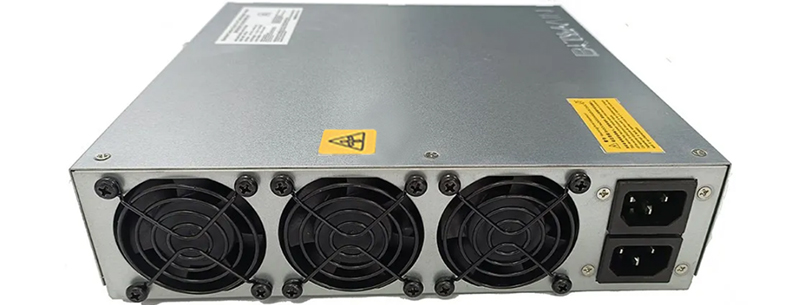
A Power Supply Unit (PSU) converts AC power into regulated DC power that ASIC chips require for operation. Bitcoin miners typically use high-efficiency switching power supplies designed for continuous operation under heavy loads. The PSU must deliver stable voltage and current across varying temperatures and hashrate demands. PSU efficiency directly impacts overall miner profitability, as power losses generate heat and increase electricity costs. Most modern mining machines use proprietary connectors and voltage specifications, making PSUs non-interchangeable between different machine models or manufacturers.
The S19j Pro from Bitmain has the following PSU specifications:
- Model: Bitmain APW12 Series (APW121215 / APW121417 variants)
- Rated Input: 200–277 V AC, 50/60 Hz
- Rated Output: 12–15 V DC (dynamic voltage range)
- Max Output Power: 3250 W – 3600 W (model dependent)
- Connector: 12-pin PSU-to-control board harness, 6-pin board-to-hashboard power leads
- Notable: Uses 450V capacitors, equipped with 3 small fans for dedicated internal cooling
2. Control Board
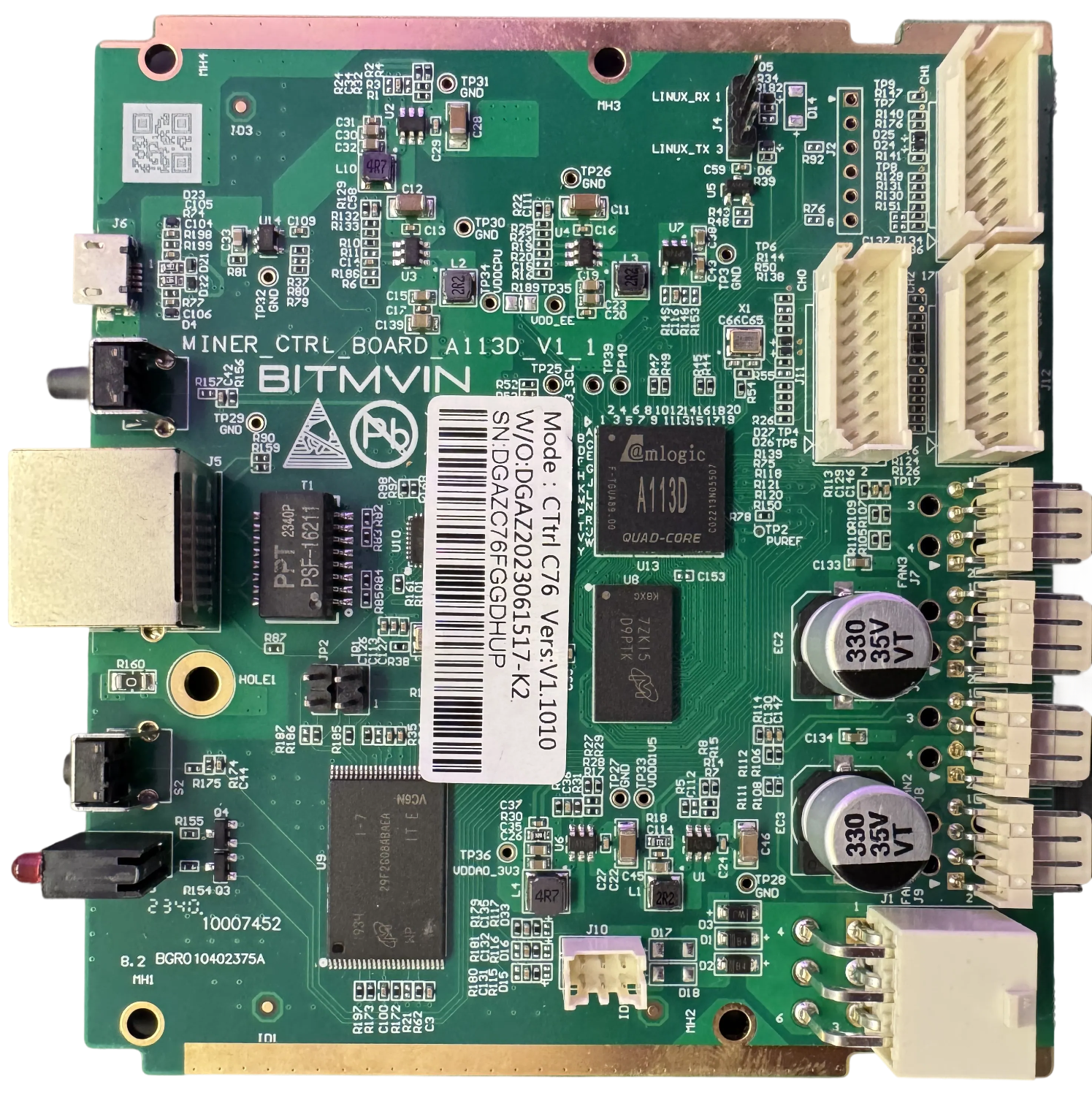
The control board is the central processor of the mining machine. It coordinates hashing operations, manages firmware, communicates with hashboards and sensors, and connects to mining pool infrastructure. Different control board types offer varying processing power, connectivity options, and firmware compatibility.
The S19j Pro from Bitmain has the following control board specifications:
- Variant(s): AMLogic / XILINX / BeagleBone
- Firmware Compatibility: Stock / LuxOS / Other
- Notable: the control board variant in your S19j Pro can impact interface speed, firmware flashing reliability, and system stability.
Most early‑batch S19j Pro units shipped with AMLogic control boards as the standard stock configuration. XILINX and BeagleBone boards typically appear in refurbished, aftermarket, or upgraded units and introduce different operational characteristics. As a result, the specific control board installed in an S19j Pro meaningfully influences firmware deployment paths and overall system stability during extended or aggressive tuning.
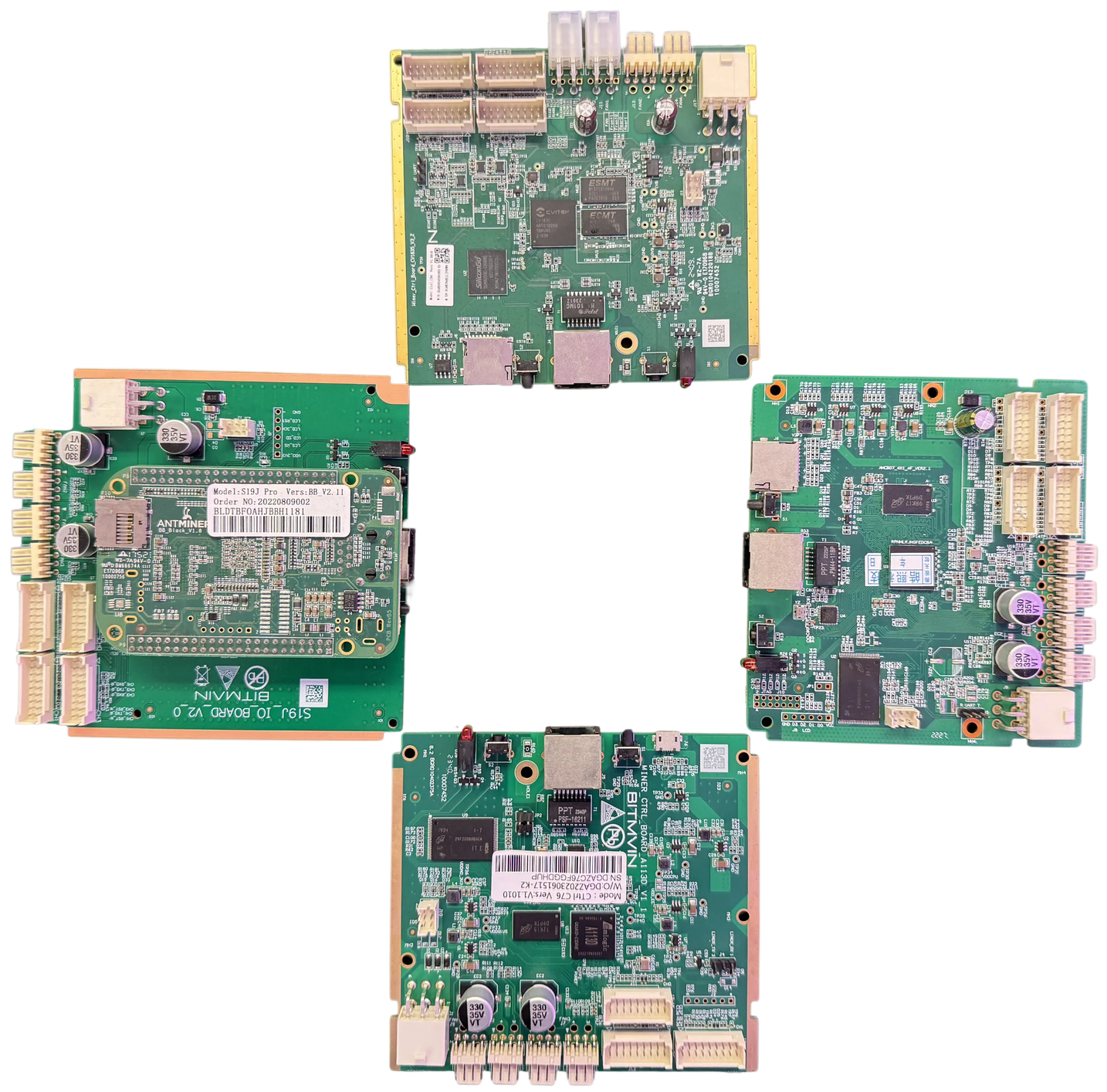
⚠️ Warning: Improper firmware flashing can permanently disable a control board. Always follow your firmware provider’s official flashing guide and checksum-verify before flashing.
3. Hashboards & ASICs

A hashboard is the core processing unit doing the work in a mining machine, populated with multiple ASIC chips that perform SHA-256 computations. Most machines use three hashboards, though this can vary. Each hashboard contains a specific number of ASIC chips arranged in a precise pattern. Different machines use different chip generations, with newer generations typically offering better power efficiency (J/TH).
The S19j Pro from Bitmain has the following specifications per hashboard:
- Total Chip Count: 378 chips (BM1362 ASICs)
- Hashboard Configuration: 3 boards × 126 chips each
- Domains: 42 x per hashboard (3 chips / domain)
- Chip Layout: Series configuration within each domain
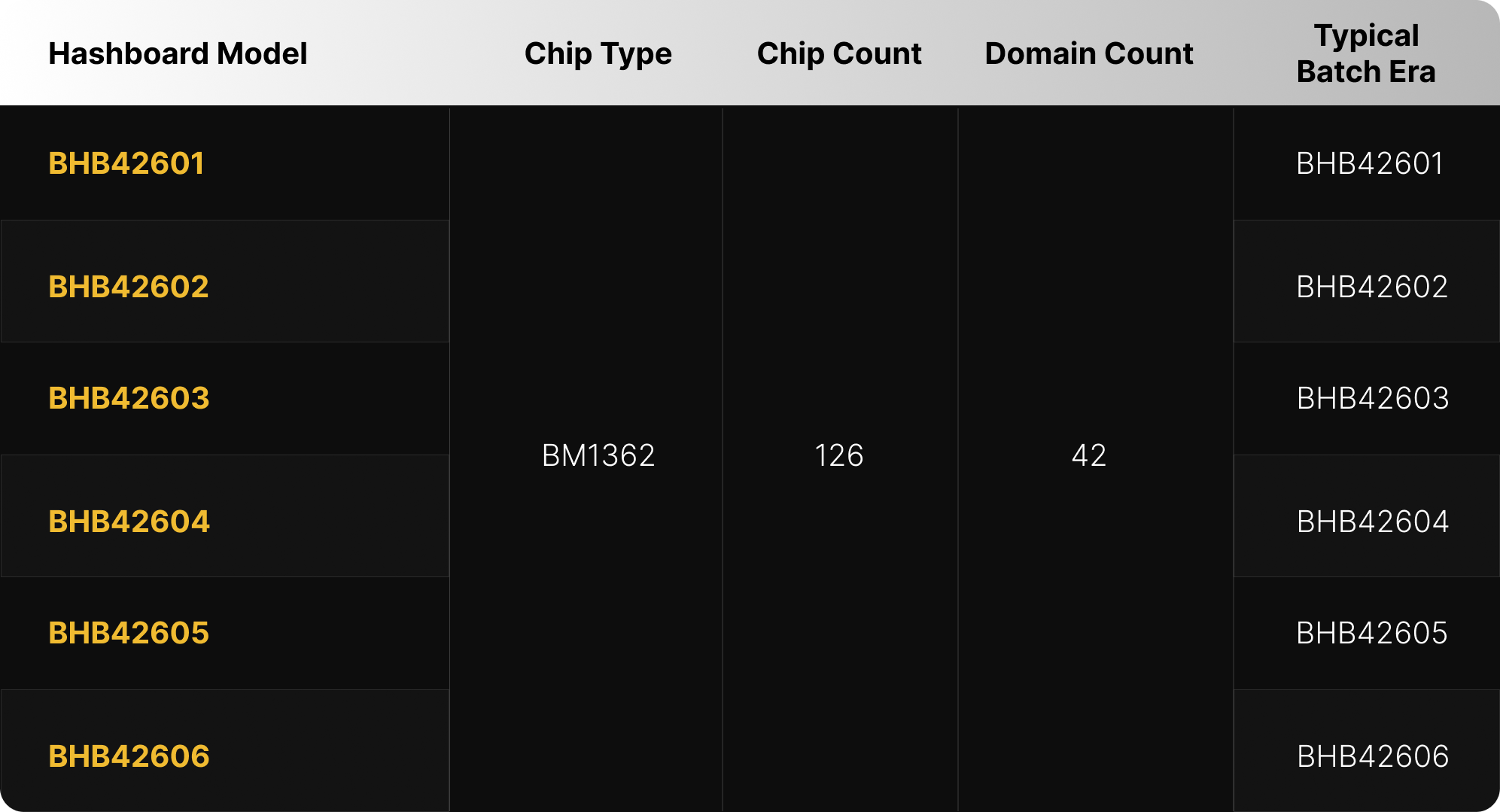

4. Cooling System

The cooling system manages thermal loads generated by ASIC chips during SHA-256 hashing operations. Most air-cooled machines use dual fans with high cubic feet per minute (CFM) ratings that pull ambient air across aluminum heatsinks attached to each hashboard. Heatsinks transfer heat from ASIC chips to the airflow through finned aluminum designs, with mounting methods varying from soldered to bolt-on configurations. Through custom firmware such as LuxOS, fan speed can be dynamically controlled based on chip temperatures, with more aggressive cooling allowing higher hashrate performance (overclock) modes. Effective thermal management is critical for maintaining chip longevity, hashrate stability, and preventing failures that reduce mining profitability.
The S19j Pro from Bitmain has the following cooling system specifications:
- Fan Spec: 4 x Dual 12V 2.4A fans, 120 × 38 mm (two intake + two exhaust)
- Heatsinks: Modular finned blocks (chipside) / single-piece extruded aluminum (backside)
- Notable: each fan delivers approximately 6000 RPM at around 360 CFM of air volume (stronger than S19 series)
- Bolted vs. soldered heatsinks enable easier servicing and integration with liquid cooling
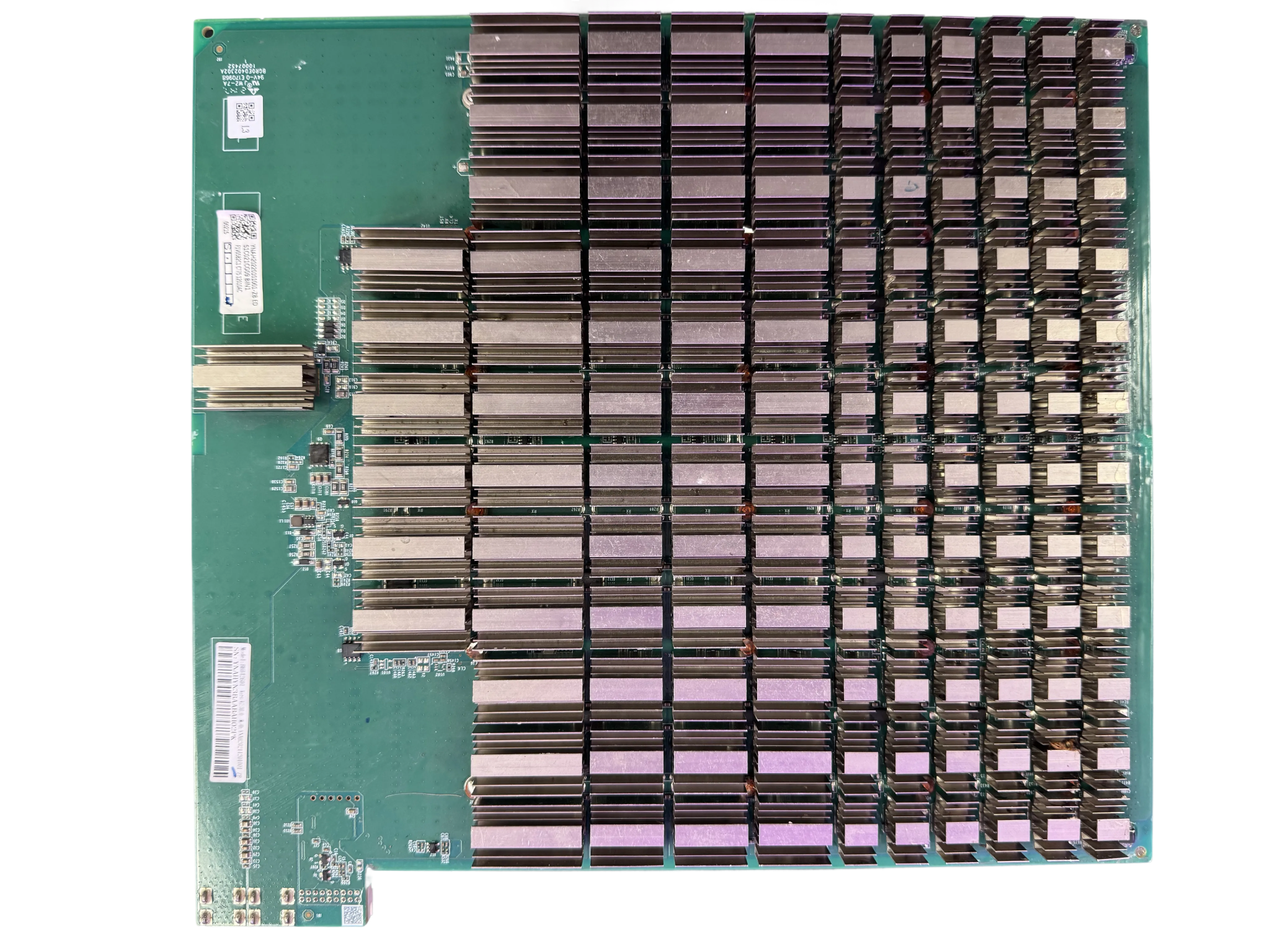

💡⚡Attention Bitcoin Miners: We’re giving away a Luxor-themed Bitaxe Touch

To enter:
- Read until the end of this blog post to find the hint.
- Amplify this post — share it on X, and tag @Luxor & @Hashrateindex.
- Comment on what part of this post stood out most, and include #HappyHashing.
Each share + tag + comment counts as one entry.
Contest closes December 25, 2025. Winner announced January 3, 2026.
Dig in to find out. Good luck, miner!
Performance Testing
For this review, both stock firmware and LuxOS performance was assessed using a 10-machine sample under identical operating conditions, including rack position, airflow, and ambient temperature held between 13–24°C (55–75°F). All power draw figures were recorded using a wattmeter. Each firmware profile was allowed to fully complete autotuning (typically ~30 minutes) prior to measurement.
Stock vs. LuxOS: Nameplate & Actual (100 TH/s Variant)
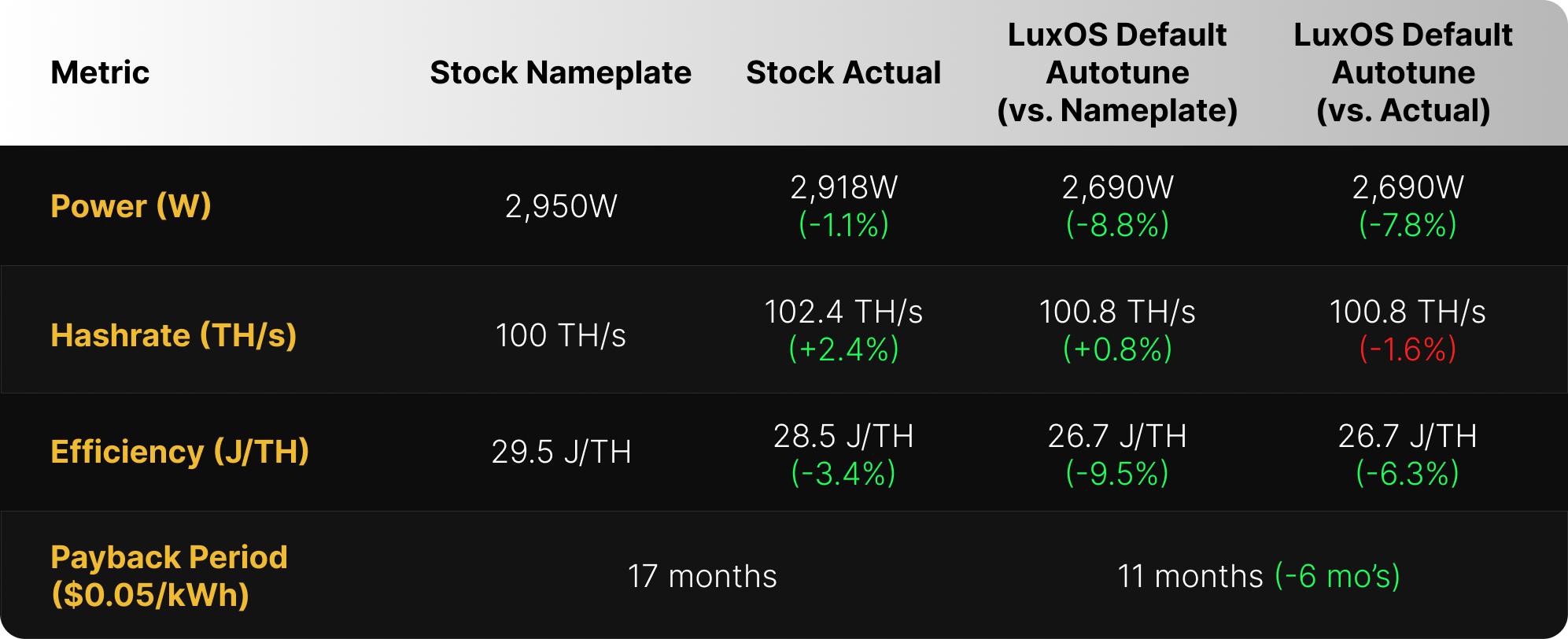
Note: All data sourced from Luxor’s R&D Fleet unless otherwise noted. To ensure accurate and reliable results when testing LuxOS, check out our Best Practices Guide.
LuxOS Profiles: Full Range with Firmware
As Bitcoin mining hardware continues to evolve and improve, efficiency remains a critical factor for miners looking to maximize profitability. The S19j Pro from Bitmain is among the most popular mid-generation mining machines available, but with Luxor’s custom firmware — LuxOS — it can unlock more efficiency and flexibility. Below, we analyze a range of performance improvements LuxOS delivers on the S19j Pro.
By default, LuxOS offers 24 profiles to choose from, including the ability to create additional custom profiles tailored to specific needs. The table below showcases nine different profiles, spanning from steps -6 to +2. These nine profiles are highlighted as a recommended range for conducting mining operations. Operators should exercise caution and remain attentive to equipment beyond this range.
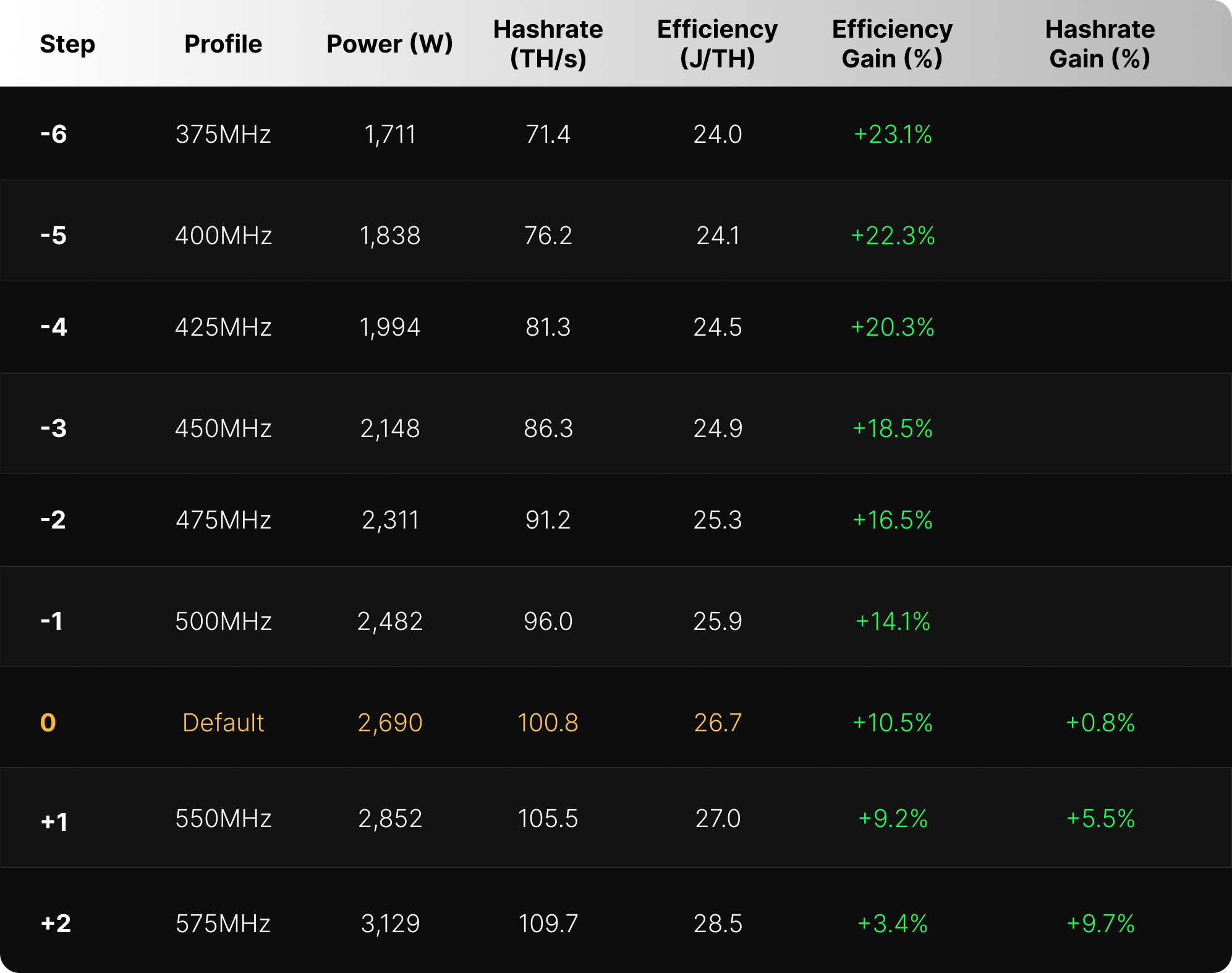
Note: All data sourced from Luxor’s R&D Fleet unless otherwise noted. Operational results may vary depending on deployment environment, firmware, and power supply configuration.
LuxOS offers multiple paths to improve profitability on the S19j Pro, depending on operational objectives.
- In its default tuning state (step 0), LuxOS achieves a modest 0.8% uplift in hashrate while improving efficiency by 10.5% over nameplate — a strong baseline with no risk of thermal overstress.
- For miners aiming to maximize revenue during periods of high hashprice or low-cost power, the +2 profile pushes hashrate to 109.7 TH/s (+9.7%) with a slight efficiency gain (+3.4)%, though this comes at the cost of higher power draw and thermal stress.
- Conversely, operators prioritizing energy efficiency may prefer the -6 profile. This deep underclock drops hashrate to 71.4 TH/s but reduces power draw to just 1,711W, delivering 24.0 J/TH (+23.1%), a significant efficiency improvement compared to stock, and the best gain observed across profiles.
Each profile represents a unique balance between hashrate output, power draw, and electrical efficiency, allowing operators to fine-tune performance parameters based on economics, thermal constraints, or infrastructure limitations. Underclocked profiles (steps -6 to -1) prioritize energy efficiency, making them ideal for environments with high power costs or grid constraints. Conversely, overclocked profiles (steps +1 and +2) boost hashrate production and may be preferable when hashprice is elevated or when Intelligent Mining.
While LuxOS enables more aggressive tuning beyond this range, doing so increases thermal and electrical stress on the hardware, potentially accelerating depreciation or causing other issues. As such, real-time monitoring and conservative thermal settings (via Advanced Thermal Management, or ATM) are strongly recommended.
Hashcost: The Other Side of The Mining Margin
While LuxOS delivers gains on the revenue side through various hashrate outputs, its real advantage often lies in cost control via improved energy efficiency. By reducing the amount of electricity required per unit of hashrate, LuxOS lowers an operation’s hashcost (or breakeven hashprice), i.e., the revenue needed to cover direct power costs. For example, in a 5-cent power scenario:
- Under Stock Firmware, the breakeven hashprice for the Antminer S19j Pro sits at $35.40/PH/day, meaning any hashprice below this level would render mining unprofitable.
- Switching to LuxOS (Default AutoTune) reduces that breakeven point to $32.03 (+9.5%), a meaningful drop that expands the profitable range of operation.
- For miners running LuxOS (-6 Profile), the breakeven hashprice falls further to $29.42, a 16.9% reduction compared to stock. This deep underclock profile improves power efficiency significantly, keeping operations online and profitable for longer under tighter market conditions.

In practical terms, this cost reduction translates to higher net profit per TH, even in flat or declining hashprice environments. As shown in the table above, net profit climbs from $2.48 (Stock) to $2.96 (LuxOS Default) and peaks at $3.02 (-6 Profile) — all without any change in external market conditions.
The hashcost curve below visualizes this efficiency unlock. At a $34 hashprice, stock firmware at 29.5 J/TH fails to break even with $0.05/kWh power. But with LuxOS, underclocking to 24.0 J/TH drops this hashcost to $29, pushing that shutdown threshold away.

Financial Analysis
Payback Period
Inputs:
- Hashprice: $41.00
- Power Cost: $0.05/kWh
- Uptime: 100%
- Machine Model: S19j Pro (100TH/s)
- Purchase Price: $2.85/T ($285/unit)
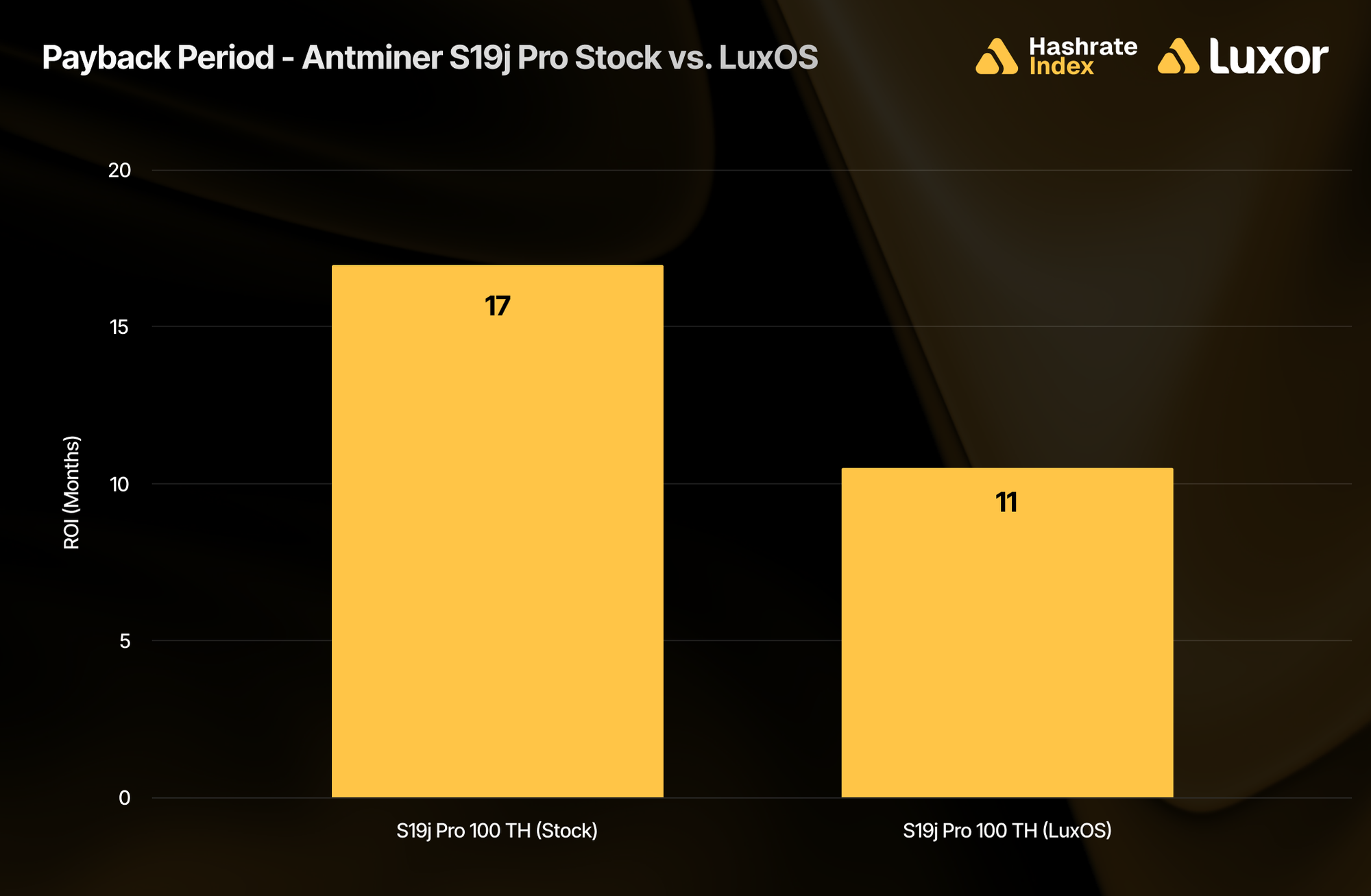
Financial Forecast
Inputs:
- Model Fleet: 10,000 x S19j Pro (100 TH)
- Capital Expenditure: $2,850,000 ($2.85/T)
- Hashprice Scenario(s):
- Luxor’s Forward Curve (November 2025 – March 2026)
- Hashrate Index's Q4-2025 Base Case Hashprice Projection (November 2025 – March 2026)
- Power Cost ($/MWh): $50, flat rate
- Fees (Firmware & Pool): 2.80%
Using forward-looking insights from Luxor’s Hashrate Forward Curve and the latest Base Case scenario from Hashrate Index Premium’s quarterly Bitcoin Mining Economics Projections Report, we project the following scenarios (November 2025 – April 2026) for the Antminer S19j Pro:


For readers interested in the full projections report featuring multiple 18-month scenarios, this is available to Hashrate Index Premium members (Gold and above). Upon request, Hashrate Index can provide custom reports in between regularly scheduled quarterly updates.
Intelligent Mining: Bringing it All Together
The most successful mining operations don’t rely on static settings. Instead, they actively interpret real-time signals across hashrate and energy markets, continuously adjusting performance to maximize profitability. Intelligent Mining is not just a concept — it’s an automation system built to win.
Intelligent Miners tune each machine like a race car — shifting into efficiency gear during peak power price intervals, slamming into overdrive when hashprice spikes, and strategically curtailing when neither side of the margin is favorable. They layer in revenue optionality from grid services, hedge hashrate when the forward curve is favorable, and integrate with software stacks that enable responsiveness. The following case study shows how these strategies come together and compound: reduced curtailment, higher uptime, lower power costs per unit of hashrate, and ultimately higher margins.
Lookback Case Study (2022 – 2025): Spot Hashprice & Spot Power
Profile
1 EH/s miner operating in ERCOT West Texas Load Zone, fully exposed to both real-time hashprice and real-time power price. The fleet consists of 10,000 Antminer S19j Pros (100 TH/s), deployed from January 2022 – August 2025.
⚠️ Disclaimer: The profitability figures in this case study reflect gross margins relative to electricity costs only. They exclude other major expenses such as hardware capex, infrastructure buildout, labor, operations & maintenance, depreciation, and financing costs. In practice, once these factors are included, net margins are significantly lower. This simplified case study is designed to isolate and illustrate the impact of Intelligent vs. binary mining decisions.
In addition, these figures exclude revenue upside opportunities from ancillary services and other alternative revenue streams.
Results
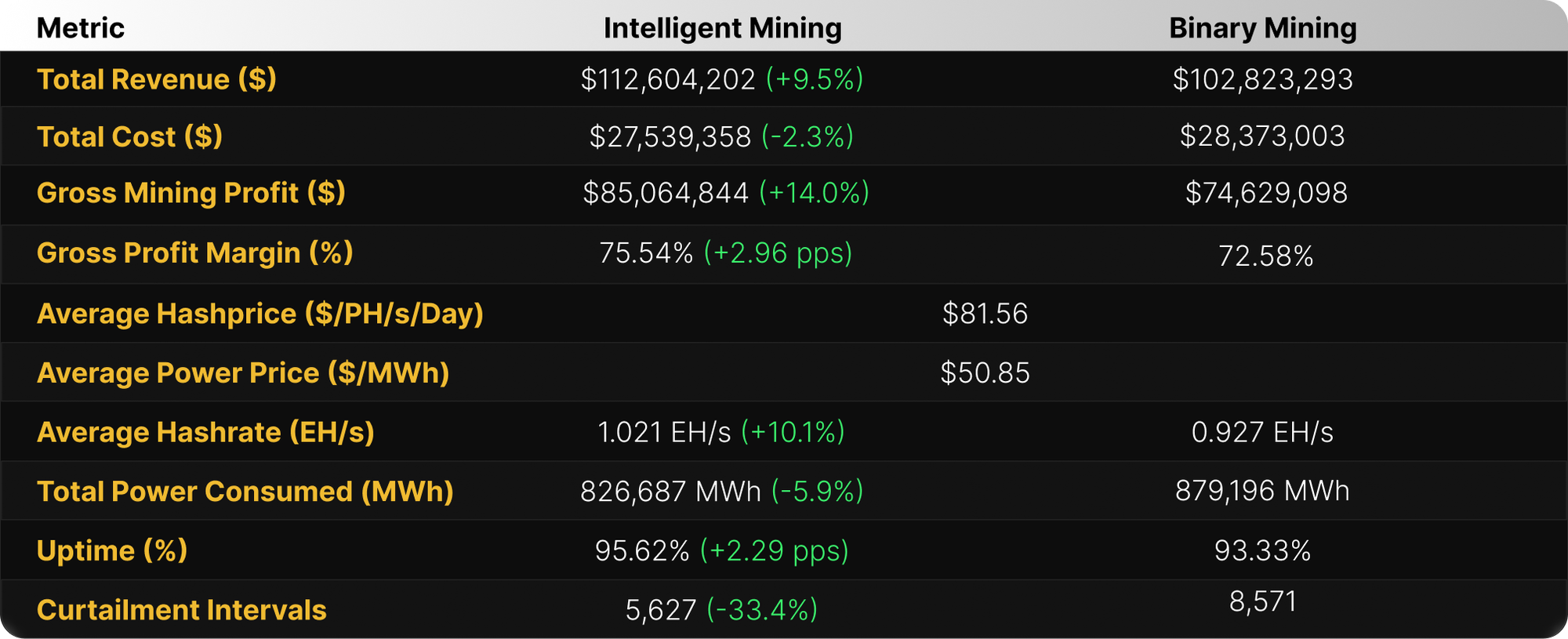

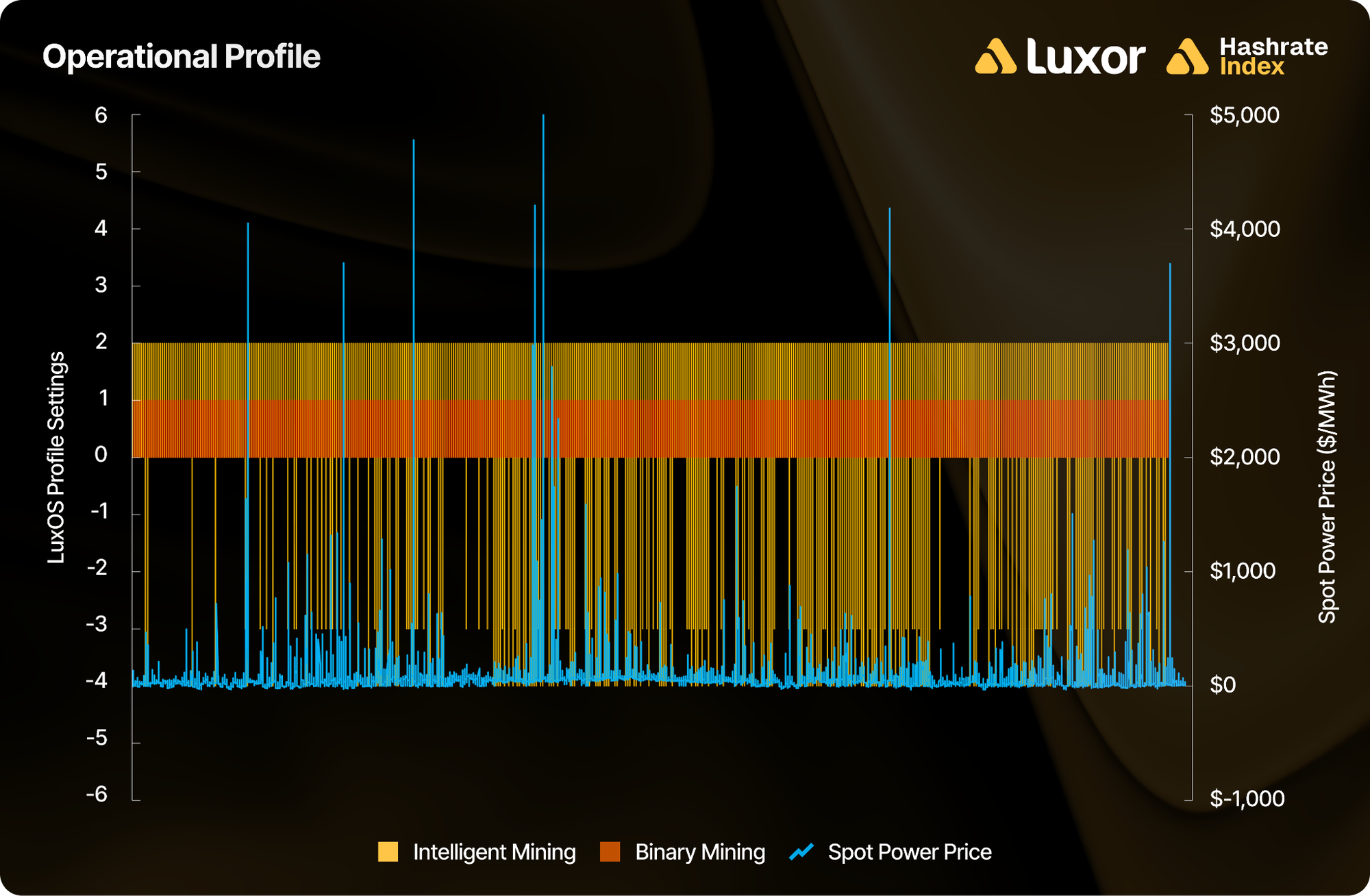
Insights
- Efficiency gains compound: By continuously autotuning and profile switching, Intelligent Mining reduced power consumption by over 52,500 MWh compared to binary mining, while delivering over 10% more average hashrate.
- Reduced curtailment: Intelligent Mining required 33% fewer curtail intervals, keeping machines online longer while still avoiding unprofitable operations. As a result, overall uptime improved by 2.5%.
- Margin expansion: Tighter cost control and higher hashrate performance improved profit margins by 2.96 percentage points.
- Snowball effect: Over four years, Intelligent Mining outperformed binary mining by 14% in cumulative profit, demonstrating how disciplined intra-interval optimization can compound into competitive advantage over time.
Conclusion
For miners exposed to the volatility of ERCOT’s West Texas zone, stock firmware strategies leave significant money on the table. Intelligent Mining turned this risk into opportunity, delivering more hashrate, lower costs, and ultimately stronger margins.
Market Positioning & Use Case(s)
Bitmain’s Antminer S19j Pro occupies a transitional position in the ASIC lifecycle. Released in 2021, it marked a major efficiency leap from its predecessor generation, becoming the dominant rig of the 2021–2023 cycle and driving industrial-scale deployments globally. While newer models boast better specs, the S19j Pro remains highly relevant due to its price-to-performance (or “bang-for-buck”) profile, abundant secondary market liquidity, and time-tested durability.
When paired with custom firmware like LuxOS, the S19j Pro becomes a versatile race car. It supports both aggressive overclocking and deep underclocking, making it suitable for miners facing volatile hashrate & power market conditions. The machine also benefits from reliable repairability and a well-understood failure profile, making it an ideal candidate for secondary market transactions, immersion retrofits, firmware experiments, and ROI-focused deployments in off-grid environments.
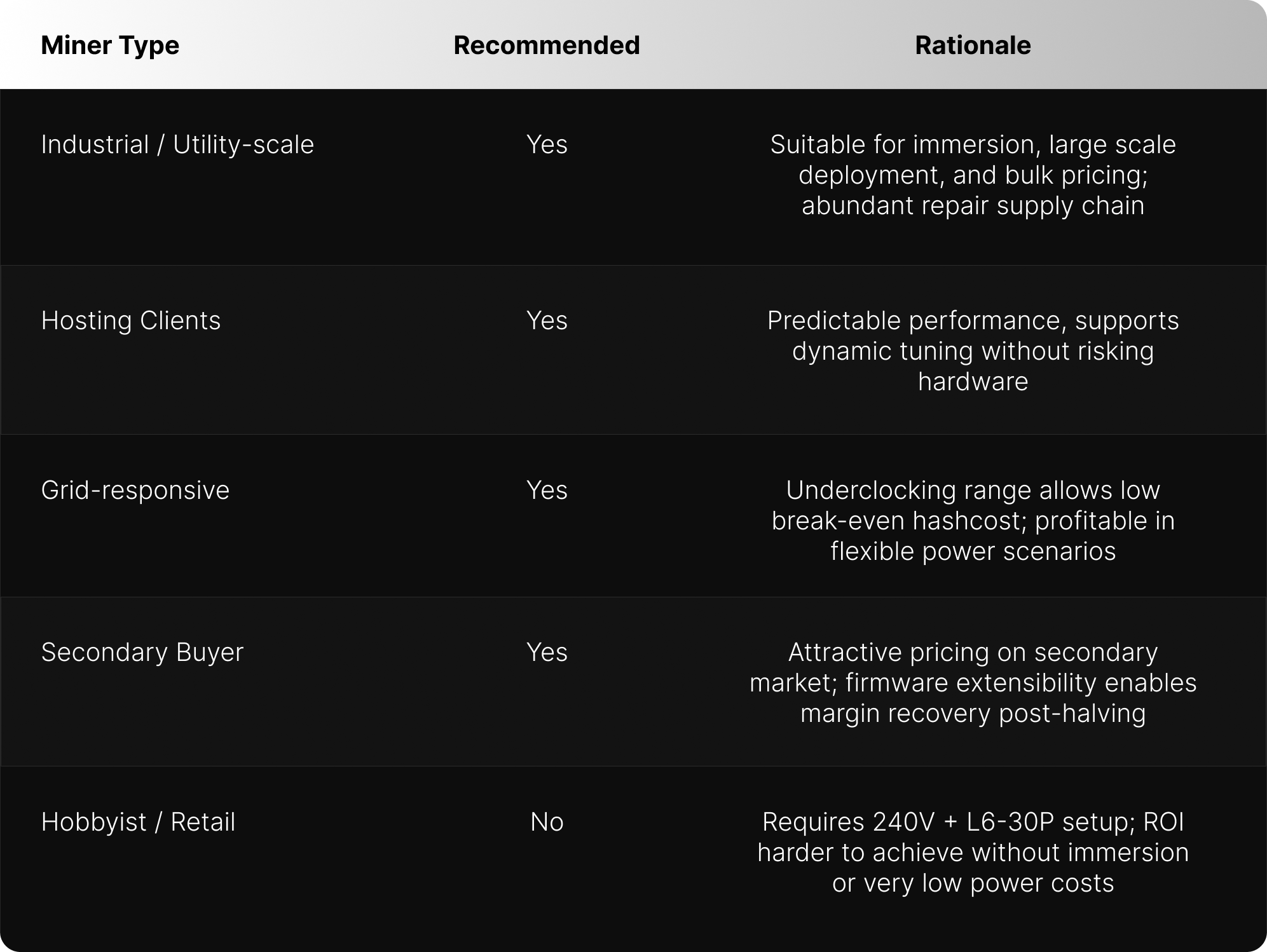
Conclusion
The Antminer S19j Pro is the quintessential mining machine of bitcoin mining. With its time-tested reputation and performance, it's here to stay online and hashing — for as long as hashprice allows. Based on our findings, it is best suited for:
- Industrial-scale deployments
- Low-cost or power-optimization strategies
- Capital-efficient fleet expansion
Scaling a Bitcoin mining operation requires capital — but issuing equity & debt or selling BTC isn't the only path. Luxor’s hashrate-backed hardware financing solutions allow miners to raise upfront capital by monetizing future hashrate production, enabling non-dilutive growth.
Through Luxor Pool, miners can choose between two repayment structures:
- Fixed Hashrate Repayment – Receive financing today and deliver a defined portion of future hashrate over time. This structure aligns repayment with operational performance and offers downside protection in weaker hashprice environments.
- Fixed Bitcoin Repayment – Secure predictable repayment terms by pairing a deliverable forward sale with a non-deliverable forward purchase. This structure removes hashrate variability from the equation while maintaining exposure to operational upside.

Our Hardware desk is currently seeing the following machines move across Bitmain’s S19 Series in secondary markets:
- S19 XP (141T): $5.80/T (MOQ 100, test before shipping)
- S19j Pro+ (120T Mixed): $3.40/T (MOQ 1000, tested before shipping)
- S19j Pro (100T Mixed): $2.85/T (MOQ 100)
- S19 (95T): $1.70/T (MOQ 50, 10-day DOA)
If you’d like to learn more about Luxor’s Full Stack Bitcoin mining services, please reach out to [email protected] or visit https://luxor.tech. To try your luck at winning a Bitaxe Touch, fill in this form.
About Luxor Technology Corporation
Luxor delivers hardware, software, and financial services that power the global compute and energy industry. Its product suite spans Bitcoin Mining Pools, ASIC Firmware, Hardware trading, Hashrate Derivatives, Energy services, and a bitcoin mining data platform, Hashrate Index.
Disclaimer
This content is for informational purposes only, you should not construe any such information or other material as legal, investment, financial, or other advice. Nothing contained in our content constitutes a solicitation, recommendation, endorsement, or offer by Luxor or any of Luxor’s employees to buy or sell any derivatives or other financial instruments in this or in any other jurisdiction in which such solicitation or offer would be unlawful under the derivatives laws of such jurisdiction.
There are risks associated with trading derivatives. Trading in derivatives involves risk of loss, loss of principal is possible.
Hashrate Index Newsletter
Join the newsletter to receive the latest updates in your inbox.

